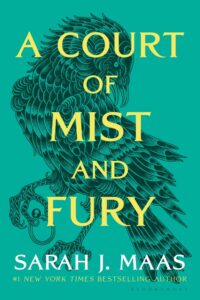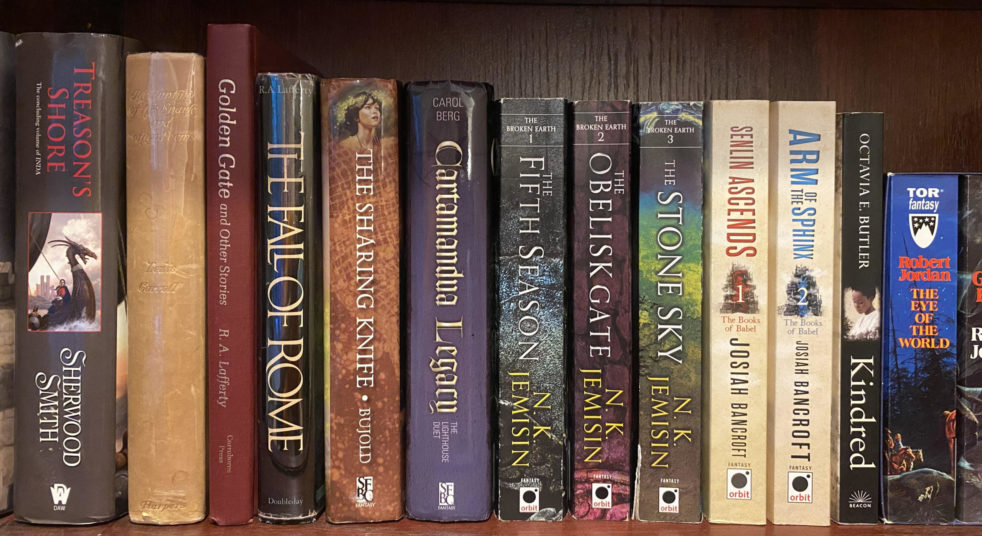
I read A Court of Thorns and Roses earlier this year to see what all the hype was about. It really wasn’t good. But then I was told that I had actually not seen what all the hype was about, because really it’s the second book in the series–A Court of Mist and Fury–that set various corners of social media aflame. And so, due to a mix of that and some light peer pressure, I read the initial A Court of Thorns and Roses trilogy by Sarah J. Maas.
Note: there are follow-up books featuring different plots or perspective characters, but I have not read those. The first three books in the series constitute a full arc, and this is a review of those books as a trilogy, without regard for any other stories published in the universe.
As I mentioned in my first review, A Court of Thorns and Roses starts out as a Beauty and the Beast retelling, with a human teenager sent to live with a shapeshifting, wolfish Faerie in order to save the lives of her family. And because it’s a Beauty and the Beast retelling, it is in large part a romance. But it doesn’t take long before the curtain is pulled back to reveal a broader conflict, with intramural wars among the Fae that have caused massive devastation in the Faerie realm and may begin to threaten human lands in the near future. And it’s that story that serves as the fantasy backbone to make this trilogy a fairly even split between the fantasy and romance elements.
Most of the trilogy is told in first-person from the perspective of Feyre, the human taken into Faerie lands in the first book, with very occasional perspective from her main love interest. It’s a breezy, easy reading style that makes the series easy to binge, closely comparable to the narration style popular in young adult fantasy. It’s also not a series with any interest in digging into Fae tropes. There are plenty of immortal characters with supernatural powers, and that’s about as far as it goes. If you read Six of Crows and wondered how all these teenagers were crime lords, A Court of Thorns and Roses is the other side of the coin: they’re centuries old, with tragic backstories around every corner, but with the emotional maturity of teenagers. If any of that is going to be a problem, don’t read this series–it’s baked in from the start. Otherwise. . . well, it’s still a mixed bag.
I mentioned in my review for A Court of Thorns and Roses (the book) that I found it inconsistent and unfocused, and because that book represents a third of the trilogy, plenty of those problems carry over. It starts as a romantic fairy tale retelling, then spins off into epic fantasy with a love triangle subplot, then commits to being a romance for a little while before spinning back into epic fantasy. That’s not a progression that’s inherently inconsistent, and the last half of it actually comes off pretty well, with a totally logical transition from a romance that sets up an epic fantasy in book two to an epic fantasy with an established couple in book three. It’s mostly book one that’s the problem here. There are flashes of what the series will become, but it’s disjointed and often slapdash, to the point where almost everything except for the climactic scenes is either retconned or recontextualized in the later books. It’s as if the author didn’t find the story she wanted to tell until she’d already written one book and just tried to make the best of it.
Because of the weakness of the first book, it’s hard for me to really recommend the series. But if you’ve already read book one for whatever reason, how are the others? Pretty entertaining! Again, it’s only going to appeal to readers who enjoy that particular narrative voice that feels so common in 2010s young adult fantasy and who aren’t demanding a portrayal of the Fae that comes especially near the classic tropes, but for readers who want to sit back and enjoy a bingeable read with fantasy and romance in equal measures, it’s a pretty solid choice.
The second book sets up the world-threatening fantasy plot that will be the focus of book three, but mostly it’s a romance, digging into a pair of characters with no shortage of trauma in their pasts and delivering an agonizingly slow buildup of romantic tension that comes to a head in a sequence that provides both emotional and sexual catharsis. That’s the primary job, and it’s done well.
Once the main couple is well established, the story turns back to the epic fantasy, with the lead and her mate digging deep both into Fae politics and into various quests for items (or beings) of power, in an attempt to build a coalition with both the might and the magic to defeat an existential threat. There are a ton of subplots here that all come together for a massive finish of the “read the last 150 pages in a single sitting” variety.
That’s not to say that the second and third books are without their flaws. Perhaps the biggest is a difficulty reckoning with a massive power imbalance in the world. Seemingly the entirety of the main cast is stronger than anyone that comes their way, and while the third book does spotlight an antagonist strong enough to create real tension, much of the intermediate drama comes from characters simply making baffling decisions to put themselves into danger—decisions that rarely seem to be recognized as mistakes (even after the fact!) by the characters involved. This is mostly a problem in the second book and the very early stages of the third, but it’s enough to break immersion on more than one occasion.
The third book also starts with a strong focus on the interpersonal elements of the upcoming conflict—building coalitions and predicting where enemies will arise—but as the book progresses and the subplots multiply, these interpersonal elements lose a bit of depth and fall into some repeated patterns. The dramatic moments are written well enough that it never really feels like a slog to read and tends to recover broken immersion quickly, but like the “danger via terrible decisions” element, it is a moment where it feels like the story is taking shortcuts to get to the good parts.
Ultimately, A Court of Thorns and Roses features three pretty different books of varying quality. The inconsistency of the first book makes it hard for me to recommend the series as a whole, but the second book delivers a compelling romance with a pair of traumatized leads and loads of sexual tension, and the third mostly puts the romance in the backstory and tells a fantasy epic with plenty of thrills. There are still some missteps, but the latter two books offer plenty of entertainment value.
Recommended if you like: fantasy romance with a breezy writing style and a bit of spice, as long as you don’t mind the series taking a while to find it’s footing.
Can I use it for Bingo? All of them have Dreams, Characters with a Disability, Reference Materials, and segments Under-the-Surface. The first and second qualify for Romantasy, though I’m not sure the third does. The first is hard mode for First in a Series, and the third is hard mode for Eldritch and is Multi-POV, at least by the letter of the law.
Overall rating: For the whole series? Probably 12 of Tar Vol’s 20, three stars on Goodreads. But that’s because the first book is 10/20 and the next two are both 14/20.
